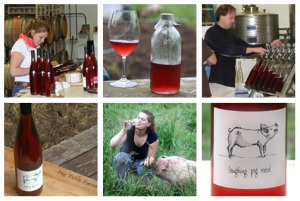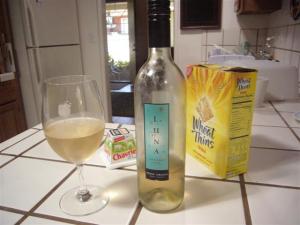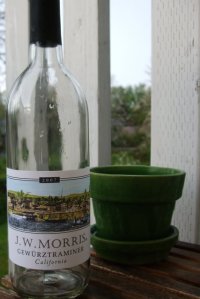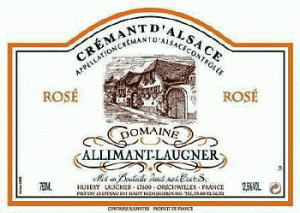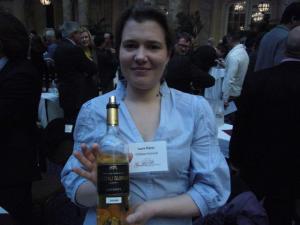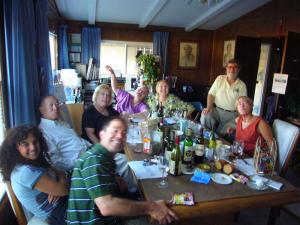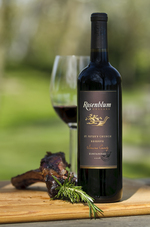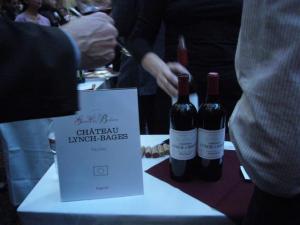By Mac McCarthy, Zenergo
Safe Wines for Beginners to Start With....
When you first try various wines, you quickly find that some -- well, many -- are hard to take, especially for a beginner. Many wines are acquired tastes -- you have to get used to them.
Especially for red wine, the tannin (a stinging, puckery sort of sensation on your tongue, similar to what you'd experience if you sucked on a teabag) is what makes it hard to take. Some red wines are very tannic, so they definitely take practice. And wines, especially red wines, can be acidic on top of that. And then there's the alcohol, which is not very high for wines (10% to 16%) compared to liquors, but liquors are hard to take too, aren't they? That's why you mix them with soda and fruit juice!
Luckily, there are a lot of wine types that are "approachable," which means easier for beginners to like right from their first taste -- they are much less tannic, less acidic, and lower in alcohol. So start with these wines that are safe for a beginner like you. NOTE: I indicate where these particular grapes and wines originate, but most are made in many places -- especially in the United States, which makes a version of almost every type of wine in the world.
[A good way to learn is to join with others to share and try wines. On Zenergo.com, you can sign up for the Wine Tasting Activity, find others in your area with similar interests, join or start your own wine tasting Group, and find out about wine tasting events in your area. Give it a try.]
Safe Reds

Beaujolais (and Beaujolais Nouveau) is an area in France that makes a very light, fruity, mild red wine from the Gamay grape, very easy to enjoy. The "Nouveau" is sold around Thanksgiving time. In fact, it makes a good turkey-day wine. (It's also supposed to be consumed before New Year's Day, as it doesn't age like the regular wines from Beaujolais do.)
Pinot Noir (but $$) Pinot Noir can be a light yet flavorful wine that's very approachable, with more interesting things going on with it than the simpler Beaujolais. It's tricky to shop for, though, for a few reasons. One is that good Pinots can be pricey. Some of the very best, from Burgundy (or "Bourgogne") in France, can have price tags that will take your breath away even more than the flavor does. And, to confuse things, many Pinots made in Oregon, Washington, and California are made in a more intense West-Coast style that's not much like the light Burgundies we're recommending here. So when you shop for a Pinot, ask the clerk if this is a "French-style" Pinot, or a "West Coast-style." Buy the French-style ones.
Rhones are blended wines made along the Rhone river in France; they can be light and easy to drink, but the flavors a highly varied – some like 'em, some don't. A famous example is Chateauneuf du Pape. Personally, I like the ones from Gigonda. Americans make Rhone-style blended wines too, and they also vary a lot in what they taste like. It's a good area for exploration.

Light Italian wines: Chianti (not in straw bottle), Sangiovese, Valpolicello are light ones easy to drink. There are other Italian reds that are intense, that you might not be able to handle as easily. One clue: If it's a light red -- if it looks watered down compared to other, dark reds -- then it's probably lighter in taste, too, so it's worth a try.
Cheap Australian Shiraz wines can be great fun because they show a lot of fruit. Examples are Yellowtail and Rosemount, and best of all they are usually very affordably priced.
Any red wine from the Finger Lakes region of New York State. Light yet flavorful, they sometimes don't say what grape is in the wine; in many cases, they are native American grapes, not the French-sourced grapes all the rest of the wines are made from, and that can be very interesting -- a lost marketing opportunity, if you ask me.
Safe Roses
I've already lectured you about why Roses can be tasty wines that you should be trying at every opportunity, despite whatever you may have heard about White Zinfandel. There is more variety in Roses than in any other wine type -- from completely "dry" to lightly sweet. And, let's face it, folks, even White Zinfandel has the not-to-be-dismissed virtue of being very easy to drink -- light, with no offensive elements, it's a perfect starter wine, which is why it's so popular. Just know that you'll get tired of it after a while because it's bland and flabby, but until that day comes, you can sip it without concern for your tongue. And please remember that this is not what other Roses taste like, nor other red Zins, nor other sweet dessert wines, so when you do get tired of it, don't swear off the good stuff.
Safe Whites
White wines, lacking tannins, are easier for beginners to taste -- though there are still a few whites that have enough acidic tang to make your taste buds jump. Whites are often lower in alcohol than reds, too, which is a bonus. The real trick for a beginner is finding a white wine that actually *tastes* good -- not just doesn't hurt, but has a flavor that a beginning taster finds pleasant and enjoyable. Here are a few popular grapes.
Chardonnay – No longer "fashionable," but easy to drink, which is why it continues to be popular. When you get tired of regular everyday Chardonnay that you find in bars and nightclubs, you can graduate to the tasty White Burgundy from France, which is very different, and to the many new "unoaked" Chardonnays being made in the US, where the fruit comes forward in a delicious way. Americans are experimenting with the taste of Chardonnay, so taste around.

Sauvignon Blanc from the US or New Zealand – This grape makes a white wine with a little more character than oaked Chardonnays, so it's a popular next step for many drinkers. It has a little but of a tang, a kind of "stony" taste. It is fashionable, though. French versions (from Bordeaux and from the Loire Valley) taste different (and good). (The Kim Crawford on the left is a famous brand from New Zealand.)
Viognier and Pinot Grigio (Italian) or Pinot Gris (French) are light white wines that vary from maker to maker a whole lot. They can sometimes have a wonderful flowery or fruity aroma--and no particular flavor; or they can be very tasty -- it's a crap shoot. Experiment.
Italian Prosecco is a sparkling white wine, like champagne but much easier to drink -- slightly sweet, fruity, fun. In fact, you should consider it for your wedding reception in place of Champagne--it's easier for non-wine-drinkers to enjoy, and it's much less expensive.
Any white from Germany, Alsace, or Austria, such as Gewurztraminer (do yourself a favor and just call it "Gevoortz"), Riesling, or Gruner Veltliner, tend to be aromatic, light but with an acidic tang, and vary from very dry to lightly sweet -- to, in the case of late-harvest "Spaetlese" and "Trockenbeerenauslese," quite sweet. All these whites vary a lot from maker to maker, so don't give up if the first ones you try you don't care much for. Keeping trying; you'll find one you like. There's a whole world of white (and red) wines, from unique grapes most of which you've never heard of and probably can't pronounce, in the world of German, Alsatian, and Austrian wines; it's worth a lifetime of flavorful study. While all the wine snobs are festishing over in France, you could becoming an expert in a different, tasty world.
Safe Late-Harvest Wines
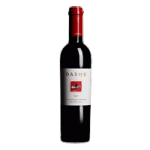 Don't like sweet wines? Ha ha ha -- you're wrong! You just haven't had a chance to try a well-made one! Seriously, though, there are many, many so-called Dessert Wines (or, for fun, "Stickies") that are unbelievably delicious -- like the best piece of liquid candy you've ever tasted. Look for Sauterne (a French white made from Sauvignon Blanc)), Tokay (Hungarian), Canadian or German Ice Wine (white), or Muscat (red). They mostly come in half-sized bottles and vary from a little bit expensive ($18 for a half bottle?) to oh-my-God expensive (hundreds of dollars for a vintage Chateau d'Yquem, also a half bottle). Try the cheap ones -- they are also tasty. And meant to be sipped--they can be very high in alcohol. (Left: Dashe Cellars makes fabulous late-harvest Zinfandels!)
Don't like sweet wines? Ha ha ha -- you're wrong! You just haven't had a chance to try a well-made one! Seriously, though, there are many, many so-called Dessert Wines (or, for fun, "Stickies") that are unbelievably delicious -- like the best piece of liquid candy you've ever tasted. Look for Sauterne (a French white made from Sauvignon Blanc)), Tokay (Hungarian), Canadian or German Ice Wine (white), or Muscat (red). They mostly come in half-sized bottles and vary from a little bit expensive ($18 for a half bottle?) to oh-my-God expensive (hundreds of dollars for a vintage Chateau d'Yquem, also a half bottle). Try the cheap ones -- they are also tasty. And meant to be sipped--they can be very high in alcohol. (Left: Dashe Cellars makes fabulous late-harvest Zinfandels!)



